What do you think of Erick’s statement?
Educate and excite, inform and infuriate.
August 3rd, 2012 — Art, Black Music, Business, Controversy, Culture, Education, Entertainment, Hip-Hop, Music, Pop Culture, Race, Work, Youth
What do you think of Erick’s statement?
April 23rd, 2010 — Culture, Entertainment, Gender, Music, NONFICTION, Radio, Work
Cellist Stephanie Winters describes the sound of her 2004 debut album, Through the Storm, rereleased in an expanded version last year, as “beautiful sadness.”
In Portuguese the word is saudade—a sadness that makes one want to live again. In a spiritual sense this recording is my “blues”. I do not use that word to describe a musical style, but to suggest the transcendent honesty which musical expression enables.
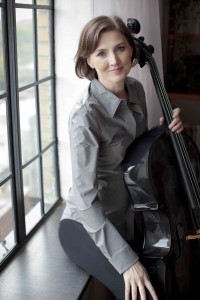 Indeed, Winters, right, through often bottomless multitracking, saturates the newly added “Mercy Street,” made famous by Peter Gabriel; her vision of Ornette Coleman’s “Lonely Woman”; or Thomas Dorsey’s renowned gospel standard, “Precious Lord, Take My Hand,” with a somber cry. The whole work breathes deep mood, yet not melancholy. In a way, it feels like a film, a wordless one, perhaps, telling a story of love found, made, lost, and unforgotten.
Indeed, Winters, right, through often bottomless multitracking, saturates the newly added “Mercy Street,” made famous by Peter Gabriel; her vision of Ornette Coleman’s “Lonely Woman”; or Thomas Dorsey’s renowned gospel standard, “Precious Lord, Take My Hand,” with a somber cry. The whole work breathes deep mood, yet not melancholy. In a way, it feels like a film, a wordless one, perhaps, telling a story of love found, made, lost, and unforgotten.
Winters has performed and recorded with Richie Havens, Enya, Corrine Bailey Rae, Anne Murray, Paula Cole, and the O’Jays, among many others.
Stephanie Winters is the guest today on my WBAI-NY / 99.5 FM radio show, NONFICTION, this afternoon, Friday, April 23, at 2 pm ET.
You can hear her ideas and music by tuning in at 2 pm ET. If you’re outside of the New York tri-state, check out our live stream on the web. If you miss the live show, dig into our archives for up to 90 days after broadcast.
April 9th, 2010 — Aviation, Books, Business, Design, Journalism, Military, NONFICTION, Photography, Radio, Technology, Work
This week, Miramar, FL-based Spirit Airlines announced that, beginning in August, passengers would be charged up to $45 per bag, not to check luggage, but to carry it onto the plane.
Their foul money grab puts a cherry on top of what airline passengers have known, seemingly, for a generation: Unless you’re rollin’ solo, above, flying is the pits.
Not from outside the plane, however. It’s in that world, where flying’s grace and beauty is palpable, that aerial photographer Erik Hildebrandt reigns.
 Hildebrandt, right, has released over half a dozen books of his work through his own company, Cleared Hot Media, Inc. (The title is a military expression meaning one has permission to engage a target.) These include Anytime, Baby: Hail and Farewell to the U.S. Navy F-14 Tomcat and his Front Row Center: Inside the Great American Air Show series, now up to four volumes.
Hildebrandt, right, has released over half a dozen books of his work through his own company, Cleared Hot Media, Inc. (The title is a military expression meaning one has permission to engage a target.) These include Anytime, Baby: Hail and Farewell to the U.S. Navy F-14 Tomcat and his Front Row Center: Inside the Great American Air Show series, now up to four volumes.
Erik Hildebrandt is the guest today on this rebroadcast from my WBAI-NY / 99.5 FM radio show, NONFICTION, this afternoon, Friday, April 9, at 2 pm ET. During our talk, we discussed the process of making pictures, how airplanes are built, the notion of warfare and the reasons for it, and more.
As well, in a few weeks, in a never-before-aired, upcoming piece, I’ll talk to him about his work as a self-publisher, that being an increasingly meaningful preoccupation in this era of media independence.
You can learn more about his work by visiting his Vulture’s Row web site, or by tuning in today at 2 pm ET. If you’re outside of the New York tri-state, check out our live stream on the web. If you miss the live show, dig into our archives for up to 90 days after broadcast.
March 30th, 2010 — Advertising, Black Music, Culture, Design, Entertainment, Hip-Hop, History, Media, Photography, Politics, Pop Culture, Race, Work, Writing
February 25th, 2010 — Animation, Design, Entertainment, Film, Media, Photography, Pop Culture, Science-Fiction, Technology, Work
At this point, millions have visited the glowing world of Pandora, in director James Cameron’s Avatar. The highest grossing film in history, with nearly $2.5 billion earned worldwide, it is, as of this past weekend, still the third-most popular film in the U.S., and has been nominated for nine Academy Awards, including Best Picture.
![]() What fewer have seen, however, is the real glimmering world of Avatar, namely, the humming, 10,000 square-foot server farm at WETA Digital, in Miramar, New Zealand, above, where the film’s photo-realistic images, above right, were wholly generated. The system literally “occupies spots 193 through 197 on the Top 500 list of the most powerful supercomputers.
What fewer have seen, however, is the real glimmering world of Avatar, namely, the humming, 10,000 square-foot server farm at WETA Digital, in Miramar, New Zealand, above, where the film’s photo-realistic images, above right, were wholly generated. The system literally “occupies spots 193 through 197 on the Top 500 list of the most powerful supercomputers.
As reported on datacenterknowledge.com,
Thirty four racks comprise the computing core, made of 32 machines each with 40,000 processors and 104 terabytes of memory. Weta systems administrator Paul Gunn said that heat exchange for their servers had to be enclosed. The “industry standard of raised floors and forced-air cooling could not keep up with the constant heat coming off the machines,” said Gunn. “We need to stack the gear closely to get the bandwidth we need and, because the data flows are so great, the storage has to be local.”
By the time the production was in its
last month or more of production those 40,000 processors were handling 7 or 8 gigabytes of data per second, running 24 hours a day. A final copy of Avatar equated to 17.28 gigabytes per minute of storage.
That’s. A. Big. File. Imagine if someone accidentally deleted it.
February 12th, 2010 — Art, Controversy, Culture, Design, Entertainment, Fashion, Gender, Obituary, Pop Culture, Work
I got the news, oddly enough, from Janet Jackson.
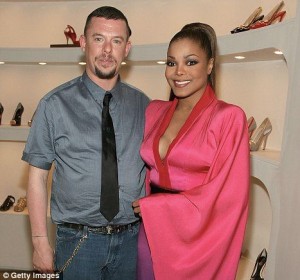 Odder still was that her words had been the very ones with which others had eulogized Michael, her brother, merely eight months earlier. I’m guessing that memory was heavy in her heart Thursday afternoon.
Odder still was that her words had been the very ones with which others had eulogized Michael, her brother, merely eight months earlier. I’m guessing that memory was heavy in her heart Thursday afternoon.
“Today we lost a True Genius, Alexander McQueen,” Janet, shown right at the opening of MCQueen’s L.A. store in 2008, posted on Twitter. “He possessed a unique creativity that will never b recaptured.”
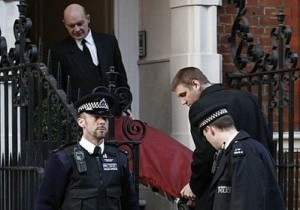 Lee Alexander McQueen was allegedly found Thursday morning in his $1M apartment by workers, hanged by his own hand at the age of 40. Police carried his body from the home, right, before it was taken away by private ambulance, according to The Daily Mail.
Lee Alexander McQueen was allegedly found Thursday morning in his $1M apartment by workers, hanged by his own hand at the age of 40. Police carried his body from the home, right, before it was taken away by private ambulance, according to The Daily Mail.
Reportedly, McQueen had been despondent over the recent death of his mother, Joyce, and, reading from the bottom, up, had apparently posted these tweets a mere eight days before his death:
 Four days later, McQueen posted these messages, where he spoke of needing to “some how pull myself together,” in order to finish the NY Fashion Week show scheduled for Thursday afternoon:
Four days later, McQueen posted these messages, where he spoke of needing to “some how pull myself together,” in order to finish the NY Fashion Week show scheduled for Thursday afternoon:
 Four days after that, McQueen was dead.
Four days after that, McQueen was dead.
 Widely credited with kicking British fashion into the 21st century a decade early—McQueen sold his company in 1991; 51% of it was folded into Gucci for £13.6 million in 2000—he remained the very Oxford definition of l’enfant terrible. He had a startling, savage talent and his couture, right, always teetered daringly on knife edges of chaos and assault. As he, himself, once said in an interview,
Widely credited with kicking British fashion into the 21st century a decade early—McQueen sold his company in 1991; 51% of it was folded into Gucci for £13.6 million in 2000—he remained the very Oxford definition of l’enfant terrible. He had a startling, savage talent and his couture, right, always teetered daringly on knife edges of chaos and assault. As he, himself, once said in an interview,
When you see a woman wearing McQueen, there’s a certain hardness to the clothes that makes her look powerful. It kind of fends people off. You have to have a lot of balls to talk to a woman wearing my clothes.
Yet, as an immensely skilled tailor in the tradition of Savile Row, where he’d once worked, he could also fashion stunningly classic, rich lines, as demonstrated in this crimson dress, worn by singer Mary J. Blige, below.
 Though not a household name, on the level of Calvin Klein or Ralph Lauren, McQueen’s talent was so big that his every show was an event. His death has devastated the fashion world, and close friends. Model Kate Moss—McQueen stands between her and model Naomi Campbell, atop this post—whom McQueen publicly supported during her drug problems, is said to be inconsolable.
Though not a household name, on the level of Calvin Klein or Ralph Lauren, McQueen’s talent was so big that his every show was an event. His death has devastated the fashion world, and close friends. Model Kate Moss—McQueen stands between her and model Naomi Campbell, atop this post—whom McQueen publicly supported during her drug problems, is said to be inconsolable.
Finally, so brightly did McQueen’s light burn in his life that, with his tragic death, lovers of his clothing are buying everything in sight, even as analysts report that, the brand “is likely to be abandoned by Gucci Group.” The king is dead. Long live the king.
January 8th, 2010 — Animals, Art, Books, Culture, Entertainment, History, Media, Music, NONFICTION, Photography, Pop Culture, Work, Youth
 Albert Watson, Jagger/Leopard, 1992
Albert Watson, Jagger/Leopard, 1992
Like a lot of legendary photographs, Albert Watson’s portrait of the Rolling Stones’s Mick Jagger, above, begins with another concept that isn’t working out.
Says the renowned lensman,
The original idea for the shooting was to have Mick Jagger driving a Corvette, with the leopard in the passenger seat. The big cat, a wild animal, seemed to suit Jagger, who likes to jump around a lot onstage, of course. However, putting the leopard in the car with him ended up being so dangerous that we had to build a partition. So, while we were waiting, I thought, “Let me try a quick double exposure with the leopard.” I shot the leopard first and drew its eyes and nose on the viewfinder of the camera. Then I rewound the film and photographed Jagger, fitting his eyes and nose over the eyes and nose of the leopard on the viewfinder so they matched. I didn’t think it would work, and I almost threw out the film. But of the twelve shots, four of them matched, and this was the best of the four that worked.
What’s amazing about the image is how, by combining the two subjects, Watson suggests a deeper truth about Jagger, inflecting his almost feline, preening aura; his famed, virtually predatory libido. I happen to think Watson’s creation story is nonsense, or, at best, incomplete. For example, did the leopard’s pupils and Jagger’s somehow match perfectly, or were the rock star’s orbs stripped in, later?
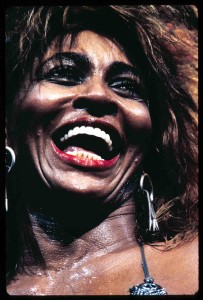 What’s without contest, however, is that this is an amazing photographic image. So is this 1985 photo by Henry Diltz of Tina Turner at LA’s Universal Amphitheater, right. Both do what photography does best: Isolate the moment with verity; freezing it so that we may contemplate and examine it in a way that is impossible in life.
What’s without contest, however, is that this is an amazing photographic image. So is this 1985 photo by Henry Diltz of Tina Turner at LA’s Universal Amphitheater, right. Both do what photography does best: Isolate the moment with verity; freezing it so that we may contemplate and examine it in a way that is impossible in life.
Jagger’s and Turner’s are two of over 200 images to be found in curator and photo historian Gail Buckland‘s Who Shot Rock and Roll: A Photographic History, 1955-Present, in which Watson’s recollection appears. (As well, an eponymous companion exhibit is at the Brooklyn Museum through January 31, after which it travels to Worcester MA, Memphis TN, Akron OH, and Columbia SC.)
Gail Buckland is a guest today on my WBAI-NY / 99.5 FM radio show, NONFICTION, this afternoon, Friday, January 8, at 2 pm ET.
 We’ll also be speaking with photog Sue Kwon, whose Street Level: New York Photographs 1987-2007 documents the seething energy of the metropolis in which she lives from a personal p.o.v. Kwon works by getting close to the people and cultures that fill the city, working at eye level, crafting typically black and white images of the sights that meter daily life of the five boroughs; for example, this image, above, of Black Israelite proselytizers.
We’ll also be speaking with photog Sue Kwon, whose Street Level: New York Photographs 1987-2007 documents the seething energy of the metropolis in which she lives from a personal p.o.v. Kwon works by getting close to the people and cultures that fill the city, working at eye level, crafting typically black and white images of the sights that meter daily life of the five boroughs; for example, this image, above, of Black Israelite proselytizers.
You can hear both Gail Buckland’s and Sue Kwon’s ideas by tuning in at 2 pm. If you’re outside of the New York tri-state, check out our live stream on the web. If you miss the live show, dig into our archives for up to 90 days after broadcast.
December 18th, 2009 — Architecture, Books, Culture, Design, NONFICTION, Pop Culture, Work
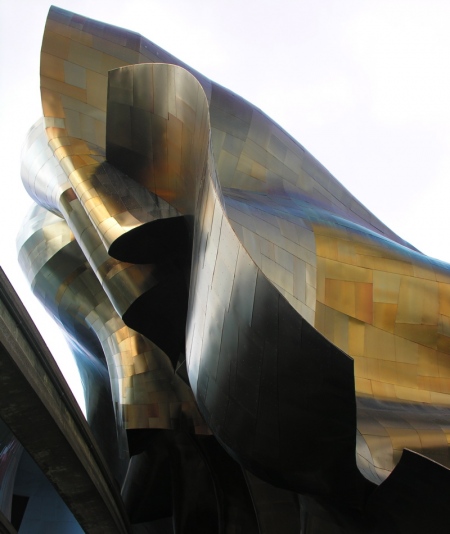 Infinity and beyond: Experience Music Project, Frank Gehry, architect
Infinity and beyond: Experience Music Project, Frank Gehry, architect
Photo by Victor Gin
 That Toronto-born Frank Gehry is the world’s most famous living architect, many would argue, is without question. It is best demonstrated, they’d say, by the instant recognizability of his style. Anywhere one sees it passionately realized—for example, in the flamelike arcs of Seattle’s Experience Music Project, above—one knows that only a single person could be responsible for that building.
That Toronto-born Frank Gehry is the world’s most famous living architect, many would argue, is without question. It is best demonstrated, they’d say, by the instant recognizability of his style. Anywhere one sees it passionately realized—for example, in the flamelike arcs of Seattle’s Experience Music Project, above—one knows that only a single person could be responsible for that building.
Others would urge that his having been awarded not only the Pritzker Prize—”architecture’s Nobel,” as it is often regarded—or the American Institute of Architects Gold Medal but also the U.S. Congress’s National Medal of Arts, above, puts him in a singular class. Still others would note that he and his work were examined in a film by an Academy Award-winning director: Sketches of Frank Gehry, by the late Sydney Pollack, one of his his last films and only documentary.
 I’d say, however, there’s really only one truly objective proof of Gehry’s renown: He’s the only architect alive to be featured on The Simpsons. In a 2005 episode, right, he’s hired to design a concert hall so that Springfield’s citizens will appear more sophisticated to their neighboring Shelbyville.
I’d say, however, there’s really only one truly objective proof of Gehry’s renown: He’s the only architect alive to be featured on The Simpsons. In a 2005 episode, right, he’s hired to design a concert hall so that Springfield’s citizens will appear more sophisticated to their neighboring Shelbyville.
Of course, that it’s ultimately closed and turned into a prison isn’t the point. It’s that Gehry’s work has so much mindshare the Simpsons‘ writers felt him suitably big enough to both feature and lampoon on a mainstream animated series. An architect.
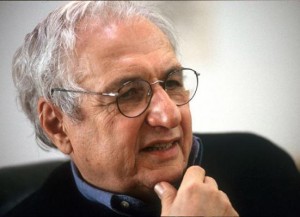 That episode aired, however, right around the time that, in real life, Gehry, right, had begun a new project with L.A.-based cultural writer Barbara Isenberg. She’d interviewed him numerous times over a twenty-year period, and Gehry, then 75, had just approached her with, literally, a once-in-a-lifetime offer. “He asked me if I would help him organize his memories through an oral history,” the journalist, below, says on her web site.
That episode aired, however, right around the time that, in real life, Gehry, right, had begun a new project with L.A.-based cultural writer Barbara Isenberg. She’d interviewed him numerous times over a twenty-year period, and Gehry, then 75, had just approached her with, literally, a once-in-a-lifetime offer. “He asked me if I would help him organize his memories through an oral history,” the journalist, below, says on her web site.
I was immediately drawn to the idea, having enjoyed our many earlier interviews, and what began as an oral history soon evolved into the conversations I’ve edited here. Since December 2004, Gehry and I have met regularly at his Los Angeles office and Santa Monica home, over restaurant breakfasts and conference room lunches. We’ve talked about the family he was born into and the families he created, who he wanted to be and who he became, what architects do generally and what he does specifically, always coming back to the family, cultural and geographic forces that have shaped his aesthetic.
Barbara Isenberg talks about Conversations with Frank Gehry, the book she authored, based on those interviews, during my WBAI-NY / 99.5 FM radio show, NONFICTION, this afternoon, Friday, December 18, at 2 pm ET.
You can hear her ideas—and Gehry’s—by tuning in at 2 pm. If you’re outside of the New York tri-state, check out our live stream on the web. If you miss the live show, dig into our archives for up to 90 days after broadcast.
September 4th, 2009 — Books, Money, NONFICTION, Work

The most interesting fact about a crappy economy is that it often compels people to finally take chances on long-cherished job dreams. In other words, once it becomes clear that, work-wise, nothing is promised, many people figure, “Why not? What have I got to lose?”
How do you make the leap, though?
Pamela Skillings was in an occupation she describes as “soul-draining.” As she told The New York Times last year,
Eventually, I realized that my salary wasn’t worth the emotional price I was paying for it. My compensation package was standing in the way of true success, which for me meant doing work that was meaningful and made me happy.
Pamela Skillings is a communications consultant who blogs on how to get out from under the corporate grind. She’s also author of the book, Escape from Corporate America: A Practical Guide to Creating the Career of Your Dreams.
Pamela’s the guest, today, in this repeat edition of my WBAI-NY / 99.5 FM radio show, NONFICTION, this afternoon, Friday, September 5, 2 pm ET.
You can hear her talk about how she made her great escape by tuning in at 2 pm. If you’re outside of the New York tri-state, check out our stream on the web. If you miss the live show, dig into our archives for up to 90 days after broadcast.
March 10th, 2009 — Architecture, Travel, Work
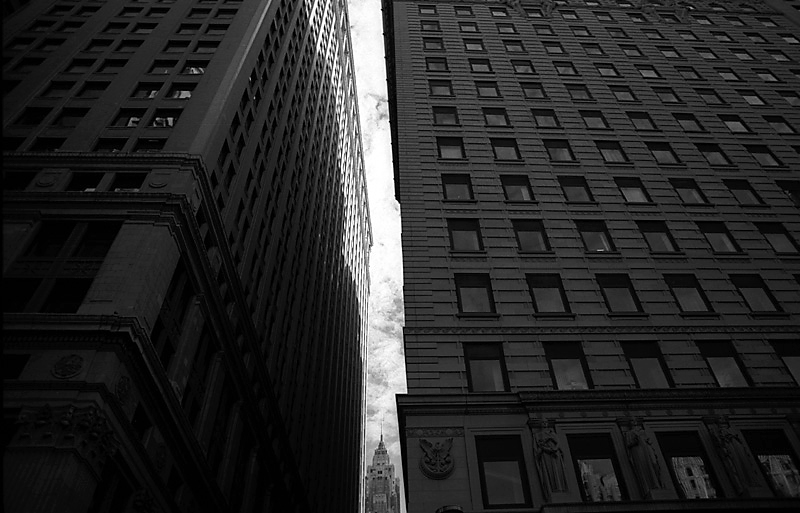
“Skyscraper Canyon” by Yeung-Seu Yoon. All rights reserved.
“I don’t think you can say one place in New York is more beautiful than another, I think they are all beautiful in their own way. But I will say that for me, Bayside, in Queens, is very green and has a lot of parks. It reminds me of Kashmir. Naturally speaking, Kashmir is more beautiful than New York, but in a different sense. New York and Kashmir are both bigger than you are. And they say if you have a problem in your soul, then Kashmir will scare you. But if you are ok in your soul, then Kashmir will inspire you. I am sure New York is the same. Anything bigger than you is like that: it will magnify what you have inside of you. Because the buildings in New York are like the mountains of Kashmir. If your soul is ok, New York will make you feel really great. But if you have something wrong in your conscience, it will scare you. Just like Kashmir.”
— Tahik, former teacher from Pakistan, cab driver in New York for four years when asked, “What’s the prettiest place in the city?”
[via The L Magazine]